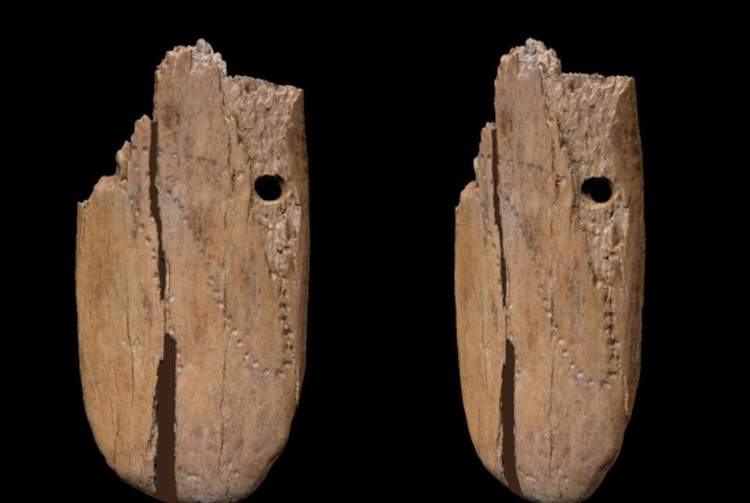Inside a cave in Poland, an ivory pendant decorated with fifty dots drawing an irregular circular curve was found in 2010. Today, thanks to studies of the jewel, it has been discovered that this is the oldest decorated ornament found so far in Eurasia, dating back 41,500 years. The discovery was reported in the journal Scientific Reports and is the result of a multidisciplinary study by a research team led by scholars from theUniversity of Bologna together with scholars from the Max Planck Institute for Human Evolution (Germany), the University of Wroc�?aw (Poland) and the Institute of Animal Systematics and Evolution of the Polish Academy of Sciences. His discovery is important because it backdates the development of this type of decoration by the first Homo sapiens to arrive in Europe by two thousand years.
“Determining the exact age of this jewel was critical to its cultural attribution, and we are thrilled with the result we achieved,” says Sahra Talamo, study coordinator and director of the BRAVHO radiocarbon laboratory at the University of Bologna’s Department of Chemistry “Giacomo Ciamician.” “This study shows that by using the latest advances in the radiocarbon method, it is possible to minimize the amount of material to be sampled and equally obtain very precise dates with a very small error range.”
In addition to radiocarbon dating, the pendant was also analyzed using digital methodologies, starting with micro-tomographic scans of the artifacts. “Through 3-D modeling techniques, the finds were virtually reconstructed and the pendant appropriately restored, while allowing for detailed measurements and supporting the description of the decorations,” adds Stefano Benazzi co-author of the paper and director of the Osteoarchaeology and Paleoanthropology Laboratory (BONES Lab) at the Department of Cultural Heritage, University of Bologna.
From the beginning of their dispersal in central and western Europe, dating back some 42,000 years, Homo sapiens groups began using ivory from mammoth tusks to make pendants and figurines, and sometimes decorating them with geometric patterns. In particular, the alignment of dots appears in some ornaments found in southwestern France and in some figurines from the Swabian Jura, Germany. However, most of these ornaments were discovered during archaeological excavations carried out in the early 1900s, so their chronological attributions remain imprecise. The chronological reconstruction of the appearance and spread of furniture art and ornaments in Europe remains highly debated and unresolved to this day.
The analysis and dating of this ornate jewelry now allows us to expand our knowledge of the timing of the appearance of these objects in Eurasia. The pendant was found in 2010 in Stajnia Cave, Poland, during archaeological investigations directed by Miko�?aj Urbanowski (co-author of the article), along with animal bones and some stone tools from the Upper Paleolithic. The traces found indicate that the cave was occupied by both Neanderthals and Sapiens, but only for sporadic visits. It was probably during one such visit, perhaps a hunting expedition to the nearby Kraków-Cz�?stochowa Plateau, that the pendant broke and was abandoned in the cave: over 40,000 years later archaeologists unearthed it.
“This jewelry shows the great creativity and extraordinary manual skill of the Homo Sapiens group that occupied the site: the thickness of the plaque is about 3.7 millimeters and shows the amazing precision in engraving the dots and the two holes for wearing it,” adds Wioletta Nowaczewska of the University of Wroc�?aw, co-author of the paper.
“Whether these marks indicate a lunar calendar or a count of prey hunted is yet to be discovered; however, it is fascinating that similar decorations appeared independently from one part of Europe to another,” says Adam Nadachowski of the Institute of Animal Systematics and Evolution of the Polish Academy of Sciences, co-author of the article.
The territory of Poland is often excluded from hypotheses regarding the first expansion of Homo sapiens into Europe, suggesting that this region remained deserted for several millennia after the disappearance of the Neanderthals. The reconstruction may now therefore be changing. “The age of the ivory pendant found in Stajnia Cave finally proves that the migration of Sapiens to Poland is as old as those in Central and Western Europe,” confirms Andrea Picin of the Max Planck Institute for Human Evolution in Leipzig, co-author of the paper. “This important result will change our perspectives on the adaptability of these early Sapiens groups and will challenge the monocentric model of artistic innovation diffusion in the Aurignacian.”
Further detailed analyses of the ivory collections found in Stajnia Cave and other sites in Poland are currently underway. “As it is today, if we want to seriously resolve the debate of when the production of ornaments and movable art in Paleolithic groups began, we need to directly date these objects with radiocarbon, especially those found during old excavations or in complex stratigraphic sequences,” Professor Talamo concludes.
The study was published in the journal Scientific Reports under the title A 41,500-year-old decorated ivory pendant from Stajnia Cave (Poland). Participating for the University of Bologna were Sahra Talamo, Silvia Cercatillo and Dragana Paleček from the Department of Chemistry “Giacomo Ciamician” together with Stefano Benazzi and Antonino Vazzana from the Department of Cultural Heritage. Also participating were from the Max Planck Institute for Human Evolution (Germany), the University of Wroc�?aw (Poland) and the Institute of Animal Systematics and Evolution of the Polish Academy of Sciences.
 |
| Discovered in Poland the oldest decorated jewel so far found in Eurasia: dating back 41,500 years |
Warning: the translation into English of the original Italian article was created using automatic tools. We undertake to review all articles, but we do not guarantee the total absence of inaccuracies in the translation due to the program. You can find the original by clicking on the ITA button. If you find any mistake,please contact us.